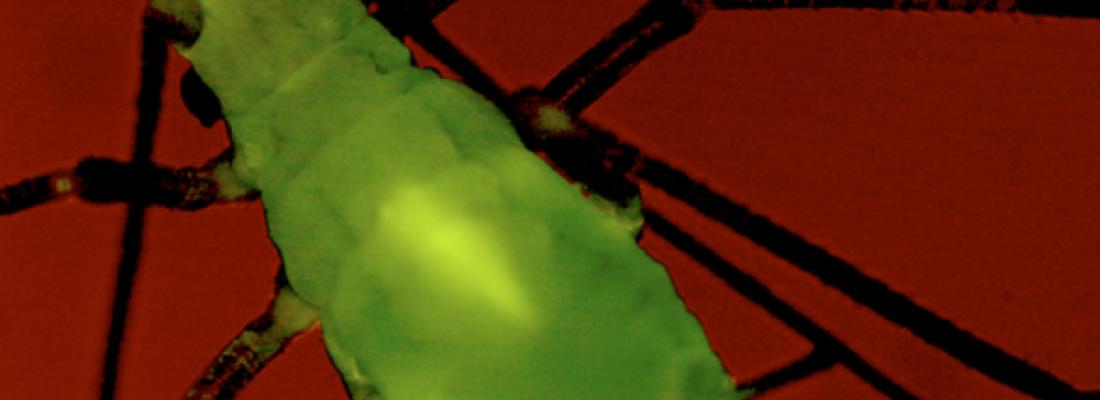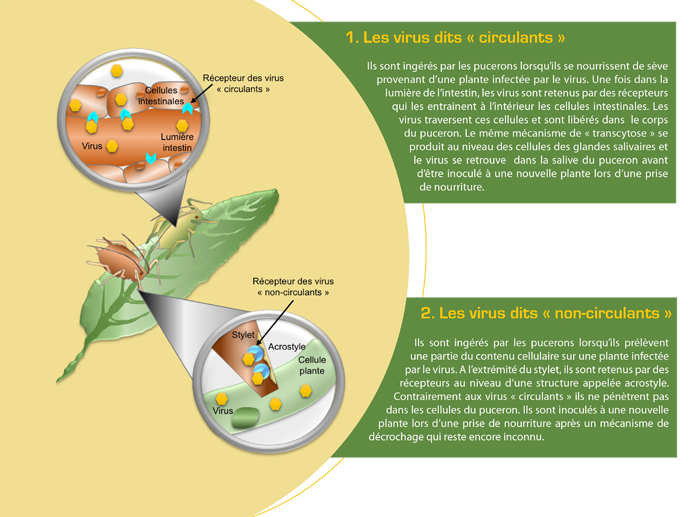Agroecology Reading time 4 min
Plant health: preventing virus transmission by aphids
Published on 23 July 2018

Plant viruses are widespread in many crops around the world, and cause important yield and economic loss. They are propagated by mobile plant-feeding organisms called vectors that transport the virus from plant to plant. Aphids are the most frequent and economically important vectors of plant viruses, transmitting hundreds of viral species. Current control methods rely mainly on chemicals, known for their negative impact on the environment and on human health.
Among other ongoing alternatives studied at INRAE (resistant crops, biocontrol, etc.), deciphering the molecular mechanisms underlying virus transmission by aphids seems a promising prospect. Identifying virus receptors in insects and understanding how they function in virus transmission should help develop strategies to specifically target and disrupt virus/vector interactions and thus impair viral spread in crops.
Two INRAE research teams (1) have worked on two distinct virus models, noncirculative viruses located on aphid mouthparts, and circulative viruses transported through the insect’s body. They shed light on a topic still poorly documented and yet a very promising developing field for alternatives to chemicals.

Proteins involved in plant virus transmission by aphids
The researchers identified two proteins involved in virus transmission by aphids using an RNA-interfering based technology referred to as “gene silencing”. This technology allows the knockdown of gene expression, and hence reduces the amount of the corresponding protein in aphids. They showed that decreasing the expression of “stylin-1” identified in aphid stylets impacted Cauliflower mosaic virus transmission by the insect. In the case of the “Ephrin receptor” protein, they observed a significant reduction in the transmission of Turnip yellows virus by aphids. It is the first report of virus transmission inhibition by targeting specific aphid proteins.
The researchers set up an original approach to immunolabel dissected stylets. Together with high-resolution microscopy observations, they discovered a tiny organ in aphid stylets, which was named acrostyle. The production of a library of antibodies (70) specifically targeting aphid cuticular proteins led to the identification of the first proteins ever characterized in insect mouthparts, among which Stylin 1 located in the acrostyle.
They looked for aphid proteins able to bind to virus particles. Interactions between the viral coat proteins and the aphid proteins were obtained and among the candidates they identified the Ephrin receptor protein.
Towards novel control strategies to limit of viral spread
These data provided unprecedented insights into the molecular mechanisms involved in virus transmission by aphids. The work contributed to the development of novel tools and innovative approaches to study the virus transmission mechanisms in aphid vectors.
Now, the two teams are pursuing their efforts on the characterization of aphid receptors for agriculturally important viruses. They would like to know whether stylin-1 is a generic receptor broadly used by noncirculative viruses, and whether Ephrin receptor is involved in the transmission of other circulative viruses such as those infecting potato or sugar beet crops.
Efforts to identify virus receptors and their potential co-factors must be pursued. A comprehensive characterization of these molecules would help target virus retention in aphids. These studies should lead to innovative control methods of viral spread by disrupting virus transmission by aphids.
(1) Joint Research Unit for Biology and Genetics of Plant-Pathogen Interactions (BGPI), INRAE Research Centre of Occitanie-Montpellier and Joint Research Unit for Grapevine Health and Wine Quality (SVQV), INRAE Research Centre of Grand Est-Colmar
Mulot Michaël, Monsion Baptiste, Boissinot Sylvaine, Rastegar Maryam, Meyer Sophie, Bochet Nicole, Brault Véronique (2018), Transmission of Turnip yellows virus byMyzus persicaeIs Reduced by Feeding Aphids on Double-Stranded RNA Targeting the Ephrin Receptor Protein, Frontiers in Microbiology, 9: 457, doi: 10.3389/fmicb.2018.00457
Craig G. Webster, Elodie Pichon, Manuella van Munster, Baptiste Monsion, Maëlle Deshoux, Daniel Gargani, Federica Calevro, Jaime Jimenez, Aranzazu Moreno, Björn Krenz, Jeremy R. Thompson, Keith L. Perry, Alberto Fereres, Stéphane Blanc, and Marilyne Uzest (2018), Identification of Plant Virus Receptor Candidates in the Stylets of Their Aphid Vectors, Journal of Virology, 92 (14):e00432-18, doi:10.1128/JVI.00432-18
-
- 2007-2011. ANR project Virus-Vection - INRA Partners http://www.agence-nationale-recherche.fr/Projet-ANR-07-BLAN-0203
- 2012-2014. Grand Challenge Explorations, phase I. Bill and Melinda Gates Foundation
- 2012-2015. "Chercheuse d’avenir" grant from Région Languedoc-Roussillon - Marilyne Uzest
- 2013-2015. Post-doc grants from INRA's Plant Health and Environment Division
- 2015-2017. PhD grant from Région Grand-Est/INRA's Plant Health and Environment Division
- 2015-2018. Grand Challenge Explorations, phase II. Bill and Melinda Gates Fondation. Partners: CNRS, Inserm, Université Lyon 1, CSIC - Madrid
- 2015-2019. ANR project StylHook - Partners: INRA, CNRS, Inserm - http://www.agence-nationale-recherche.fr/Projet-ANR-15-CE20-0011
